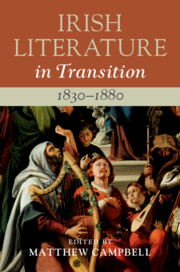Book contents
- Irish Literature in Transition, 1830–1880
- Irish Literature in Transition
- Irish Literature in Transition, 1830–1880
- Copyright page
- Contents
- Contributors
- Series Preface
- General Acknowledgements
- Acknowledgements
- Part I Contexts and Contents: Politics and Periodicals
- Part II Ireland and the Liberal Arts and Sciences
- Part III From the Four Nations to the Globalising Irish
- Part IV The Languages of Literature
- Chapter 12 Antiquarians and Authentics: Survival and Revival in Gaelic Writing
- Chapter 13 Poetry and Its Audiences: Club, Street, Ballad
- Chapter 14 Realism, Allegory, Gothic: The Irish Victorian Novel
- Chapter 15 The Rise of the Woman Writer
- Chapter 16 Dion Boucicault and the Globalised Irish Stage
- Chapter 17 Popular Prints
- Index
Chapter 15 - The Rise of the Woman Writer
from Part IV - The Languages of Literature
Published online by Cambridge University Press: 29 February 2020
- Irish Literature in Transition, 1830–1880
- Irish Literature in Transition
- Irish Literature in Transition, 1830–1880
- Copyright page
- Contents
- Contributors
- Series Preface
- General Acknowledgements
- Acknowledgements
- Part I Contexts and Contents: Politics and Periodicals
- Part II Ireland and the Liberal Arts and Sciences
- Part III From the Four Nations to the Globalising Irish
- Part IV The Languages of Literature
- Chapter 12 Antiquarians and Authentics: Survival and Revival in Gaelic Writing
- Chapter 13 Poetry and Its Audiences: Club, Street, Ballad
- Chapter 14 Realism, Allegory, Gothic: The Irish Victorian Novel
- Chapter 15 The Rise of the Woman Writer
- Chapter 16 Dion Boucicault and the Globalised Irish Stage
- Chapter 17 Popular Prints
- Index
Summary
Drawing on new archival research into book history, letters and periodical literature, this chapter explores the critical narratives around what it meant to be a woman writer between 1830 and 1880 via a focus on case studies of two Irish woman writers: Maria Edgeworth (1768–1849) and Mrs S. C. Hall (1800–1881). This focused approach allows a comprehensive placing of Irish women writers within the developing literary marketplace of their time and consideration of the extent to which the contemporary critical reception of their work has shaped subsequent scholarship. In doing so, the chapter uncovers a narrative of peaks and troughs, epitomised by periods of great esteem and critical disdain, and highlights the fluctuating patterns of visibility and invisibility of literary productions in the nineteenth century and beyond.
Keywords
- Type
- Chapter
- Information
- Irish Literature in Transition, 1830–1880 , pp. 257 - 279Publisher: Cambridge University PressPrint publication year: 2020

